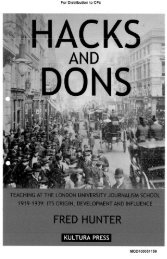The Edi ' - The Leveson Inquiry
The Edi ' - The Leveson Inquiry
The Edi ' - The Leveson Inquiry
You also want an ePaper? Increase the reach of your titles
YUMPU automatically turns print PDFs into web optimized ePapers that Google loves.
Priv<br />
shot<br />
phol<br />
rul~<br />
sex<br />
the<br />
For Distribution to CPs<br />
~rivacy is always a hot issue. Complaints about intrusion account<br />
~for a auarter of the PCC’s cases, and cover the whole spectrum<br />
of national and regional newspapers and magazines in almost eaual<br />
proportion ....<br />
This reflects the genuine and w~aespreaa conflict over wnere<br />
legitimate public exposure ends and Dublts prurience aegina. When<br />
dealing with pubfic figures there can be a further dimension: now<br />
mucn ~s this prunenca encouraged by ca]ebnties themsefves? <strong>The</strong>re<br />
Is no deflnit{ve answer to these auestions, it is a matter of balance<br />
ann judgment according to all the circumstances. <strong>The</strong> Code attempts<br />
to embrace that and manage the conflicts in Clause 3, by two means.<br />
First, in setting out the zones of pdvacy, it echoes the language of<br />
L ~.’<br />
the Human R=ghts ACt -- the entitlement to rsspect for private and<br />
family li~, home, hsalth and correspondence. In June 2004, the Code<br />
added to this digital communicatlons, thus undenmmg Clause 10’s<br />
stncturas on the use of bugging devices.<br />
Second, the Code’s Dan on intrusive photography makes clear<br />
that consent would be needed to take pictures of individuals on<br />
public or p~te preperty where there is a reasonable expectation of<br />
privacy<br />
<strong>The</strong> panel<br />
This attempts to protect individuals by tntroducmg a test of what<br />
co]our code<br />
was reasonable, with each case judged on ~ts merits the flna<br />
~ What the<br />
arbiter of which would be the PCC with its lay rnajorlty As this clause<br />
Code says<br />
offers the possibifity of a public interest defenca, that too is often<br />
Key<br />
factored into the equation, oues~ons<br />
<strong>The</strong> wide discretion the clause gives to the PCC makes its<br />
ea~[orsneea<br />
to ~s}<br />
decisions vital in influencing editorial judgments and setting public themselves<br />
when Code<br />
expectations of the press. Among the guiding principles it considers<br />
ssues anse<br />
n reaching those decisions:<br />
~ Briefings<br />
¯ . . . on specific<br />
Prtvacy =a ~o~ an abael~e r~g~t -- ~t can be compromised by areaswhem<br />
conduct or consent, For example, when considering complaints<br />
theCode<br />
applies<br />
of alleged intrus=ons, the PCC has traditionally had regard for any<br />
relevant previous disclosures by the cornpIainant. Since October<br />
2009, that has been codified in Clause 3ii, which states: "Account<br />
will be taken of the complainant’s own public disclosures of<br />
information. °<br />
Privacy is n~t a ~mrno~ity which can be sold on one person’s<br />
MOD100036632<br />
57
















